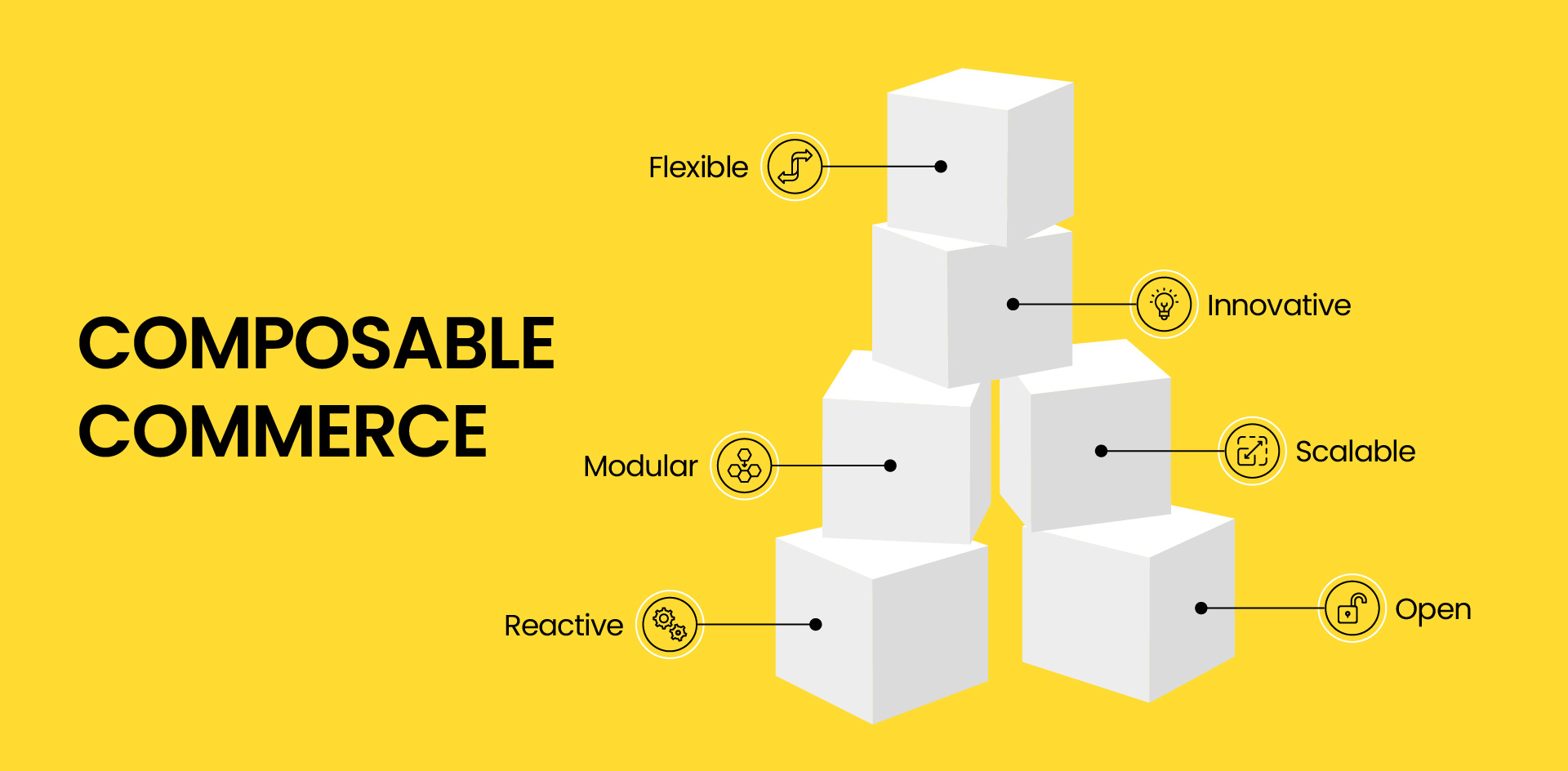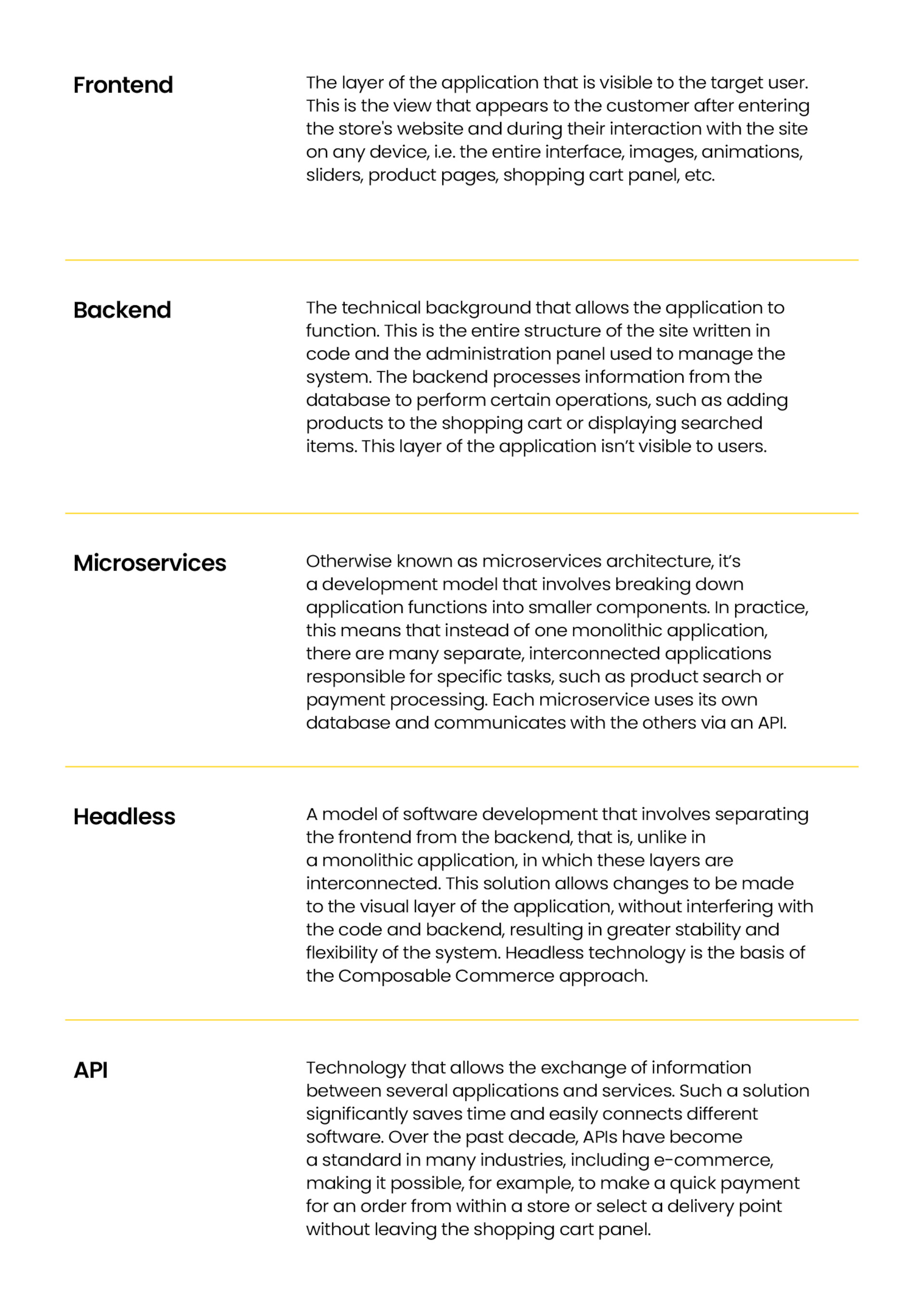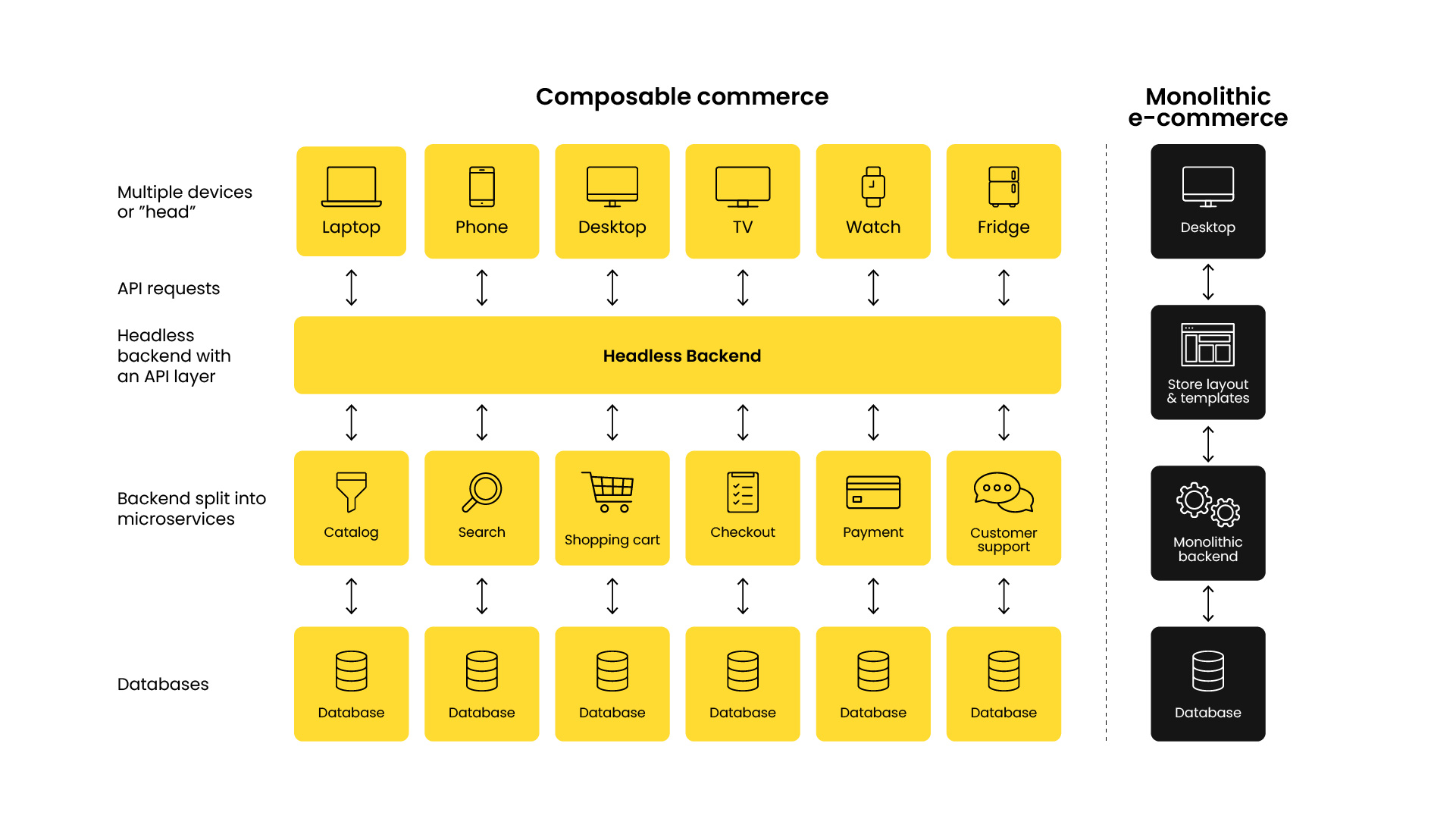In order to answer your request, we are obligated to process the data given above. Sometimes, however, we would like to use them for slightly different purposes, such as statistical data or informing you about our new products and services.We promise that we will use the given information for communication purposes only. We also remind you that you can unsubscribe from our mailing at any time (see Privacy Policy).
In rapidly evolving online businesses, we witness groundbreaking innovations almost every day, but some make more of a fuss than others. In online sales, such a milestone is undoubtedly the Composable Commerce approach. What is it and why is it so important for e-commerce? Let's find out!
Composable Commerce - a new approach to digital commerce
Composable Commerce is a modern approach to building online stores by composing sales applications from specialized modules called Packaged Business Capabilities (PBCs). Each PBC is responsible for a different stage of the platform's operation, such as checkout, search, product information management, or shopping cart.
The various components of an application can come from different vendors specialized in their field. For example, if an online store is built on the Magento platform, developers are not limited only by the functionalities offered by Magento but can connect third-party integrations to the system. Thanks to Composable Commerce, the owner of an online store is assured that the solutions used come from the best vendors on the market, and the possibilities for expansion are almost unlimited.
The Composable Commerce allows to create a system that is perfectly tailored to the individual needs of each business, as it’s not limited by the capabilities of a closed all-in-one platform. What's more, modular applications are more flexible, reactive, and easy to scale because modifications can be made within individual building blocks and don’t require rebuilding the system as a whole. Such agility enables better responsiveness to customer expectations and needs and improves their experience.

How did Composable Commerce become an industry standard?
The term "Composable Commerce" was first proposed in 2020 in a Gartner report as an alternative to the monolithic model of building sales applications. Gartner portrayed modular systems as the future of the digital commerce market, supporting the implementation of omnichannel strategy and enabling unprecedented extensibility and agility.
The company predicted that by 2023, up to 50% of new commerce solutions will be offered as API-centric SaaS services, and commerce businesses that have implemented Composable Commerce will outpace the competition by 80% in the speed of deployment of new functionality.
Looking at today's e-commerce business landscape, there is no doubt that these predictions have proven accurate. Major e-commerce players, including Castorama, Medicover, Zalando, Allegro, and Uber are using the Composable Commerce architecture to react instantly to market changes and optimize their platforms.
Monolithic application vs. modular application
Many innovations are created in contradiction to the existing standard, which at some point simply stops working. Composable Commerce was no different. The new modular approach to sales application design was developed as an alternative to the monolithic model that had dominated the architecture of e-commerce platforms for years.
Monolithic approach
A monolith is referred to as a self-sufficient all-in-one system in which the user interface, data handling, business logic, and applications function as a whole in a single code base. The design philosophy is to create a self-contained and independent application that handles not only individual tasks but also each subsequent step needed to perform a function.
Monolithic applications have served their purpose for years, but as the digital commerce sector has grown, their nature has become a constraint on business development. The monolithic structure of the system makes it much more difficult to modify, as any change requires rebuilding, code changes, retesting, and redeployment. It's a bit like a machine that you have to take apart, expand and reassemble from scratch to add more components to it.
For this reason, introducing new functionality or responding to market changes requires more time and work on the part of the development team and increases the risk of error. Also, the more you expand the store, the more complicated and slow it becomes, as the whole system is more burdened with additional operations, and this compromises the user experience.
Modular approach
A modular application, which is the essence of the Composable Commerce approach, is a system built from separate Packaged Business Capabilities that communicate with each other through an API. The architecture of such a platform is a bit like building with LEGO bricks, with the difference that you can use components from different manufacturers and they will all fit together through integration.
In Composable Commerce, each of the modular components is a separate entity specialized in its task, uses its own database and handles the specific operations it is assigned to, without involving the other parts of the system. This is somewhat reminiscent of a large company, where each department is responsible for a different business area, such as marketing, sales, HR, and development. In a well-functioning organization, the various teams work together and exchange information when necessary, but on a day-to-day basis, each has its own set of duties and responsibilities. And in the case of a modular application, it's the same.
Each block handles its own stage of the purchase path, such as payment or search, but the different parts of the system communicate with each other to ensure consistency and the highest quality of experience. This division of tasks within the application allows for increased efficiency and speed, as each module handles its own pool of tasks without involving the entire system unnecessarily.
Headless Commerce, Microservices, and APIs in digital commerce
Composable Commerce is not a technology per se, but an approach to building applications. It is something like agile methodology for development, a set of certain guidelines and recommendations of specific technological solutions. Among the most important are headless architecture, microservices, and APIs. Below we discuss the most important terms that will help you understand it a little better.

How does it work in practice?
Take a look at the graphic of the Composable Commerce solution structure. It shows a comparison of two building models of digital commerce solutions - API first headless commerce and traditional monolithic architecture.

At the first level, we have the frontend. The different elements of the frontend are created independently for different types of devices, so the website is profiled to the requirements of a laptop, smartwatch, smartphone, etc. This allows the brand to effectively sell in multiple channels and optimize the customer experience regardless of the device. Each layer of the frontend is plugged into a single backend, which allows for significantly increase efficiency and simplify system management.
On the second level, we have a headless backend with an API layer, which allows the frontend layer to communicate with the backend and vice versa. The API layer also allows developers to connect tools from third-party vendors to the system and expand the store with numerous integrations.
On the third level, there is the backend. It’s divided into microservices, which are independent components made up of code fragments. Each of them works with its own database. There can be individual microservices for different elements of the store: product catalog, search, shopping cart, payment, customer relationship management, or customer service. Such a solution allows for increasing the efficiency of the system because each microservice is responsible for its own pool of tasks.
At the bottom, we have databases that store and organize information about the online store. The backend provides information from the database to the frontend layer (i.e. the first level, or "head") via various API formats, such as JSON, GraphQL, etc.
The Benefits of Composable Commerce
The popularity of Composable Commerce is growing not only because it is a new fashion and curiosity, but mainly because it provides genuine business benefits.
Speed of response
The market is changing dynamically – today's standards may soon become obsolete, and solutions that were just novelties in a while will become a condition for staying afloat in a sea of competition. Composable Commerce allows for the speed of updating the system and adding new functionality, without having to rebuild the entire application.
Best-of-breed services
With Composable Commerce, the system is not limited to the capabilities of a closed environment. The development team can deploy the best available services offered by various vendors specialized in their field.
Flexibility of the system
When building monolithic applications, the company has to think ahead about it’s business goals and anticipate the reactions of the audience. Composable Commerce offers much more flexibility because we can test different ecommerce solutions, implement them as needed, and roll them back if they don't work. It helps to develop a system that works in practice, instead of relying on theoretical premises.
Better customer experience
Customers today are accustomed to a maximally simplified shopping path and the feeling that an online store is practically reading their minds. Composable Commerce is key to building an ever-improving consumer experience and quickly implementing new solutions that customers expect.
Omnichannel sales
With multiple frontend layers in a headless commerce, it’s easy to optimize the ecommerce platform for different devices and effectively implement an omnichannel strategy.
Innovation
Composable Commerce allows deploying cutting-edge solutions in the market as soon as they appear. This not only allows you to reap the benefits of modern solutions faster but also strengthens the image of a modern commerce company, which is beneficial from a marketing and promotional point of view.
Scalability
One of the biggest challenges for modern commerce is finding new technologies that keep up with the pace of their growth. Supporting dynamic growth is one of the most important tenets of the Composable Commerce. The ease of expansion of a modular application supports scalability because the system is not limited by the capabilities of a closed all-in-one platform.
Composable Commerce is the future of online sales
80% of businesses that don't have headless commerce today say they plan to implement it in the next two years. Moreover, 77% of organizations with headless architecture say it enables faster changes to storefronts. Today, Composable Commerce is more than a trend and a novelty, it’s the standard for modern e-commerce and a way to gain a competitive advantage.

-1.png)



